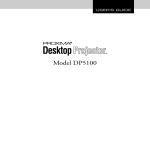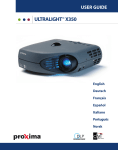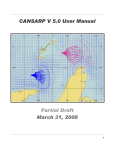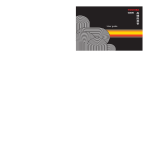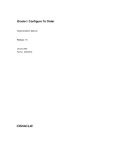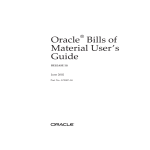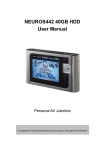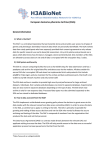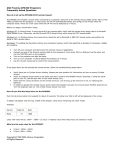Download Proxima Multimedia LCD Projectors Halogen User`s guide
Transcript
USER’S GUIDE Multimedia LCD Projectors Halogen Models This manual covers all of the Desktop Projector halogen models. These projectors have many aspects in common. Unless otherwise indicated, the information contained within this manual is common to all models. Warranty Proxima Corporation warrants that the Proxima® Desktop Projector™ product manufactured by Proxima is free from defects in materials and workmanship under normal use during the Warranty Period. The Warranty Period commences on the day of purchase by the end-user. The Warranty Period is one year. The projector lamp is not covered by this Warranty. Each Proxima product is manufactured from new parts, or new and some used parts. In some cases, the product may have been delivered to another end-user and then returned. In all cases, the product has undergone testing and quality inspection, and Proxima's full warranty terms apply. The end-user’s sales receipt or invoice showing the date of purchase of the product and the name of the Reseller is proof of date of purchase. The Warranty extends only to the original purchaser and is not transferable. During the Warranty Period, Proxima will, at no additional charge, repair or replace defective parts or at the option of Proxima, replace the entire unit. Limitation of This limited Warranty does not extend to any Proxima product that has been damaged or Warranties been rendered defective (a) as a result of accident, misuse or other abuse; (b) by the use of parts not manufactured or sold by Proxima; (c) by modification of the product; or (d) as a result of servicing by non-authorized personnel. The foregoing Warranty is expressly in lieu of any other expressed or implied warranties, including, without limitation, warranties of merchantability or fitness for a particular purpose. To the extent not prohibited by law, all statutory warranties are hereby waived and excluded from this Warranty. Proxima expressly disclaims all warranties not stated in this Limited Warranty. FCC Warning: This equipment generates, uses and can radiate radio frequency energy and, if not Statement installed and used in accordance with the instruction manual, may cause interference to radio communications. It has been tested and found to comply with limits for a Class “A” computing device pursuant to Subpart B of Part 15 of the FCC Rules, which are designed to provide reasonable protection against such interference when operated in a commercial environment. Operation of this equipment in a residential area is likely to cause interference in which case the user, at his own expense, will be required to take whatever measures may be necessary to correct the interference. Trademarks, Proxima and Cyclops are registered trademarks; Desktop Projector, Desktop Projection, Patents, and LightBoard, and Fit-To-View are trademarks of Proxima Corporation. The appearance of Copyright the projector housing of the DP2XXX family is a registered trademark of Proxima Corporation. IBM is a registered trademark of International Business Machines Corporation. Macintosh is a registered trademark of Apple Computer, Inc. Other trademarks are the property of their respective owners. This product is covered by one or more of the following U.S. and foreign patent numbers: 5,062,001, 5,137,484, 5,153,568, 5,177,629, 5,181,015, 5,225,875, 5,264,835, 5,276,436, 5,298,892, 5,299,039, 5,300,944, 5,302,946, 5,321,450, 5,400,095, 5,453,803, 5,459,484, 5,483,382, 5,489,923, 5,499,036, 5,502,459, 5,504,501, 5,510,861, 5,512,967, 5,515,079, and DES. 360,426. Foreign patent numbers Canada Registered Design No.74980 D Proxima Corporation 1994, British Registered Design No.2 038 977, Germany Registered Design No. M 94 03 987.9 geschutztes Muster, Under Geschmacksmusterschutz, China Patent for Design No.94303399.3, Japan Registered Design No.948294, South Korea Registered Design No.174628, Australia Pat. Nos. 644 852, 668 823. Other US and foreign patents applied for. © 1996 Proxima Corporation. All rights reserved. Specifications are subject to change without notice.US and foreign patents applied for. Contents Chapter 1 Introducing the Proxima Desktop Projector Chapter 2 Detailed Setup Cyclops Interactive Pointer System .................................. 1–2 What’s in the Box? ........................................................... 1–2 Quick Start ...................................................................... 1–4 Desktop Computers ................................................. 1–4 Notebooks/Laptops .................................................. 1–4 Control Panel ........................................................... 1–6 Warning and Alert Lights ......................................... 1–7 Levels Menu ............................................................. 1–7 Setup Menu ............................................................. 1–8 Remote Control ....................................................... 1–9 Getting Help .......................................................... 1–10 Your Proxima Desktop Projector ..................................... 2–1 Getting Started ................................................................ 2–2 Opening the Projector .............................................. 2–2 Closing the Projector ................................................ 2–6 Transporting the Projector ....................................... 2–7 Connecting the Desktop Projector .................................. 2–8 COMPUTER .......................................................... 2–9 RS–232 .................................................................. 2–12 VIDEO IN............................................................. 2–12 S–VHS ................................................................... 2–13 COMPUTER AUDIO IN..................................... 2–14 AUDIO IN ............................................................ 2–14 Connecting a Microphone ..................................... 2–15 AUDIO OUT ........................................................ 2–16 Powering Up ................................................................. 2–18 Applying Power to the Projector ............................ 2–18 Turning On/Off the Lamp..................................... 2–21 Projecting the Image ...................................................... 2–22 Image Size .............................................................. 2–22 Focusing ................................................................. 2–23 Keystoning ............................................................. 2–24 Chapter 3 Using the Desktop Projector The Control Panel ........................................................... 3–1 Arrow Keys ............................................................... 3–1 BRIGHTNESS Keys ................................................ 3–2 LAMP Key ............................................................... 3–2 MENU/ (CYCLOPS) Key .................................. 3–2 SYNC Keys .............................................................. 3–3 VIDEO Key ............................................................. 3–3 VOLUME Keys ....................................................... 3–4 Menu Settings ................................................................. 3–4 Selecting and Changing Settings .............................. 3–4 Saving Changes ........................................................ 3–4 Levels Menu .................................................................... 3–5 BRIGHTNESS ........................................................ 3–5 SYNC ....................................................................... 3–5 VOLUME ................................................................ 3–6 RGB Controls: RED, GREEN & BLUE ................. 3–6 TINT ....................................................................... 3–6 SIG LEVEL .............................................................. 3–6 Setup Menu ..................................................................... 3–7 SOURCE ................................................................. 3–7 IMAGE .................................................................... 3–8 COLORS ................................................................. 3–8 PROJECTION ........................................................ 3–9 FREQUENCY ......................................................... 3–9 LANGUAGE ......................................................... 3–10 STORE? ................................................................. 3–10 SETTINGS ............................................................ 3–10 Warning and Alert Lights .............................................. 3–11 OVERTEMP Warning Light ................................. 3–11 REPLACE LAMP Alert Light ................................ 3–12 Remote Control ............................................................. 3–13 MUTE Key ............................................................ 3–13 TEXT Key ............................................................. 3–14 REV, PAUSE and FWD Keys ................................ 3–14 Chapter 4 Maintenance Chapter 5 Troubleshooting Cleaning the Lens and Mirror ......................................... 4–1 General Maintenance....................................................... 4–2 Switching Lamps ...................................................... 4–2 Replacing Lamps ...................................................... 4–3 Changing Air Filters ................................................. 4–5 Changing the Remote Control’s Batteries ................ 4–9 Temperature Extremes ........................................... 4–10 Troubleshooting Chart .................................................... 5–1 Where to Get Help .......................................................... 5–4 Appendix A Specifications Appendix B Accessories & Replacement Parts Index Chapter 1 • Introducing the Proxima ® Desktop Projector Chapter 1 Introducing the Proxima Desktop Projector The Proxima® Desktop Projector™ family consists of portable, color data and video LCD desktop projection products that make sharing data and presenting information as easy as connecting your computer to your monitor. 800 600 400 200 0 800 600 APR MAY JU N 400 200 0 APR MAY JUN JUL JUL PROXIM A Figure 1-1 The Proxima Desktop Projector in use User’s Guide • 1–1 Chapter 1 • Introducing the Proxima® Desktop Projector This manual covers all of the Desktop Projector halogen models. These projectors have many aspects in common. Unless otherwise indicated, the information contained within this manual is common to all models. Where controls, operations, or other aspects differ between models, the projectors will be distinguished with regard to video compatibility. Models that support video will be referred to as audio/video-enabled. Models that do not support video will be referred to as audio-enabled. Cyclops Interactive Pointer System What’s in the Box? ☞ 1–2 • User’s Guide All Proxima Desktop Projector halogen models come Cyclopscapable. Cyclops is an interactive pointer system that functions like a cordless mouse and lets you control your computer and software from the projection screen. After you’ve opened the box and removed the Desktop Projector and shrink-wrapped accessory packs, make sure you have all of the items shown in Figure 1-2. CAUTION! The Desktop Projector should be treated like any other precision optical instrument. Handle it carefully. Chapter 1 • Introducing the Proxima ® Desktop Projector VIDEO MENU CYCLOPS FREEZE – – < REV keys + TEXT +– VOLUME PAUSE FWD Blue LAMP SYNC BRIGHT NESS = PC/MAC Remote > + MUTE softwa re Proxima Desktop Projector Composite Video/Audio Cable* (C497-6) VGA Video Y-Cable (C454-6) Remote Control (A26) S-Video Cable* (C466-6) Power Cord (C1002–6) Computer Audio Cable* (C498-6) Macintosh Video Y-Cable (C464-6) RCA "Y" Adapter* (C496) Also included but not shown: • • • • • Mac and VGA Video Terminators Dust Cover (2) AAA Alkaline Batteries User's Guide Product Registration Card * Audio/video-enabled models only Figure 1-2 Items included with the Desktop Projector The international version has three extra power cords for Europe (part number C1003-6), Great Britain (part number C1011-6), and Italy (part number C1012-6). User’s Guide • 1–3 Chapter 1 • Introducing the Proxima® Desktop Projector Quick Start 1. Place the projector on a solid flat surface at a right angle (perpendicular) to the projection screen, parallel to the floor. 2. Raise the cover assembly until it clicks into place. 3. Raise the mirror assembly into its fully open position. For steps 4 through 7, follow the appropriate section for your system. Desktop Computers 4. Make sure that the computer and the monitor are turned off. 5. Unplug the monitor cable from the computer and attach it to the MONITOR end of the “Y” cable. 6. Plug the “Y” cable’s COMPUTER (or CPU) end into the computer’s monitor port. 7. Insert the “Y” cable’s LCD end into the projector’s COMPUTER port. If these steps complete your preliminary configuration, continue with Step 8 at the bottom of the page. Notebooks/Laptops 4. Make sure that the computer is turned off. 5. Plug the “Y” cable’s COMPUTER (or CPU) end into the computer’s monitor port. 6. Insert the “Y” cable’s LCD end into the projector’s COMPUTER port. 7. Attach the Macintosh or VGA video terminator to the “Y” cable’s MONITOR end or plug in an external monitor. 8. Connect video and audio sources to the projector: 1–4 • User’s Guide Chapter 1 • Introducing the Proxima ® Desktop Projector Connector RS-232 Function/Cable For optional Cyclops system or Presentation Control Software - Din 8-to-DB9 IBM serial data cable (C936-6) - Macintosh ADB data cable (C470-6) for Cyclops - Macintosh serial data cable for Mac Remote (C934-6) Connections Installation instructions included with Cyclops system or Presentation Control software COMPUTER Connects computer video to projector - VGA video “Y” cable (C454-6) - Macintosh video “Y” cable (C464-6) Projector: LCD Monitor: MONITOR IBM: COMPUTER/VGA Mac: CPU/MAC II S-VHS (Audio/video enabled models) S-VHS or S-Video input - S-Video cable (C466-6) Projector: - Source: - VIDEO IN (Audio/video enabled models) Video input from NTSC, PAL, or SECAM - Composite video/audio cable (C497-6) COMPUTER AUDIO IN - Projector: Audio input from computer or microphone - Computer audio cable (C498-6) Projector: - - Connects an external speaker system - Computer audio cable (C498 6) L/R AUDIO IN White (L)/Red (R) RCA plugs Source: L/R AUDIO OUT White (L)/Red (R) RCA plugs COMPUTER AUDIO IN RCA plugs Source: AUDIO OUT Mini jack Projector: - AUDIO OUT Mini jack External Amplifier: - ✍ VIDEO OUT Yellow RCA plug Audio input from NTSC/PAL/SECAM/S-VHS source or microphone - Composite video/audio cable (C497-6) - VIDEO IN Yellow RCA plug Source: AUDIO OUT VIDEO OUT Mini Din 4 Projector: AUDIO IN S-VHS Mini Din 4 L/R AUDIO IN L/R RCA plugs The lamp comes on automatically when you turn on the projector. DO NOT LOOK DIRECTLY INTO THE LENS WHEN THE LAMP IS ON! Your vision can be damaged by the brightness of the light. CAUTION: 9. Plug in the projector. Turn on the projector and any external monitor before you turn on the computer, so that the computer properly senses the projector during its start-up routine. 10. Rotate the projector’s focus ring until the title screen image is clear and sharp. User’s Guide • 1–5 Chapter 1 • Introducing the Proxima® Desktop Projector Control Panel Volume Video Brightness Menu/ OVERTEMP Sync Lamp REPLACE LAMP Figure 1-3 The control panel CONTROL VOLUME FUNCTION Adjusts audio level of the projector's internal speakers. BRIGHTNESS Increases/decreases brightness of the projected image. SYNC Compensates for fine variations in the timing of the computer video signal. VIDEO Switches between computer video, NTSC/PAL/SECAM video, or S-VHS. MENU/ Press once to display the Levels menu. Press again to display the Setup menu. Press a third time to exit the Menu window. Hold down for several seconds to initiate (optional) Cyclops light measurement sequence. Hold down when powering up projector to disable Cyclops. LAMP Toggles the projection lamp ON/OFF. ARROWS Make small adjustments to the projected image's position. Changes Menu Window settings when in MENU mode. - Press the Right/Left arrow key to move to the setting. - Press the Up/Down arrow key to change the setting. 1–6 • User’s Guide Chapter 1 • Introducing the Proxima ® Desktop Projector Warning and Alert Lights Warning and alert lights on the control panel indicate the Desktop Projector’s operating condition. OVERTEMP Illuminates in the unlikely event the projector reaches an over–temperature condition. REPLACE LAMP Illuminates if the active and/or spare projector lamp burns out. Levels Menu Press the MENU/ key once to display the Levels Menu. This menu varies automatically based on the type of video source displayed. BRIGHTNESS SYNC RED GREEN VOLUME BLUE Figure 1-4 Levels Menu for computer video BRIGHTNESS R TINT G SIG LEVEL VOLUME Figure 1-5 Levels Menu for NTSC/PAL/SECAM and S–VHS video CONTROL FUNCTION BRIGHTNESS Increases/decreases the overall brightness of the projected image. SYNC Compensates for fine variations in the timing of the computer video signal. VOLUME Adjusts the audio level of the projector’s internal speakers. RED Adjusts the red color signal for computer video. GREEN Adjusts the green color signal for computer video. BLUE Adjusts the blue color signal for computer video. TINT Adjusts the Red and Green color balance for NTSC/PAL/SECAM/S-VHS video. SIG LEVEL Adjusts the difference between light and dark segments of the projected image. User’s Guide • 1–7 Chapter 1 • Introducing the Proxima® Desktop Projector Setup Menu Press the MENU/ key a second time to display the Setup Menu. SOURCE VGA640x480 IMAGE NORMAL COLORS 226981 PROJECTION FORWARD FREQUENCY 800 LANGUAGE ENGLISH STORE? NO SETTINGS FACTORY Figure 1-6 Setup Menu CONTROL SOURCE FUNCTION Lists the name of the input source detected by the projector. Accessible in modes where other choices are available, based on the type of signal the projector is receiving. IMAGE Switches between NORMAL and REVERSE modes. REVERSE is used primarily for viewing text screens. COLORS Selects the color mode most suitable for the projected image. PROJECTION Flips the displayed image for use with a rear projection screen. FREQUENCY Synchronizes the projector with the video source. LANGUAGE Switches the language set used in the Menu Window: English, French, German, Italian, and Spanish. Note: Adjust SYNC before changing FREQUENCY. STORE? Saves settings currently displayed in both Menus. SETTINGS Retrieves factory–set or stored settings, or saves the current settings. 1–8 • User’s Guide Chapter 1 • Introducing the Proxima ® Desktop Projector Remote Control The Remote Control contains all the key functions available on the Control Panel and provides access to additional functions not available on the Control Panel or through the Menu Window. VIDEO MENU CYCLOPS LAMP FREEZE – SYNC + TEXT - BRIGHTNESS + < REV PAUSE - VOLUME + FWD > MUTE Active Matrix Blue keys = PC/MAC Remote softw Figure 1-7 Remote control unit CONTROL FUNCTION MUTE Toggles sound OFF/ON to the internal and external speakers TEXT Toggles between VGA text mode of 640 x 400 lines and DOS text mode of 720 x 400 lines. DOS text is easier to view when using Text mode. REV PAUSE FWD Works with Proxima’s Presentation Control Software, which can be used to sequence electronic slides. Detailed instructions are included with the software. FREEZE Freezes the image. Press it a second time to continue.Use this to skip over a slide, or to do a freeze-frame during video or animation. User’s Guide • 1–9 Chapter 1 • Introducing the Proxima® Desktop Projector Getting Help For technical support, please contact your dealer or call Proxima at: U.S.A. and Canada Outside U.S.A. and Canada (619) 457-5500 Press 1 for Customer Service. (619) 457-8542 (fax) (619) 457-5500 Press 1 for Customer Service. (619) 622-0173 (fax) 1–10 • User’s Guide Europe +31-43-358-5200 +31-43-358-5201 (Fax) Chapter 2 • Detailed Setup Chapter 2 Detailed Setup Your Proxima Desktop Projector Before you begin, examine the components of the projector. 4 5 3 3 2 1 VIDEO MENU CYCLOP S FREEZE – – < REV keys + TEXT +– VOLUME PAUSE FWD Blue LAMP SYNC BRIGHT NESS = PC/MAC Remote > + MUTE softwa re 10 7 6 7 8 9 16 11 15 14 S-VHS VIDEO IN 12 13 Figure 2-1 The Proxima Desktop Projector and Remote Control (1) Control Panel (2) Mirror Assembly (3) Internal Speakers (4) Cover Assembly (5) Top Air Intake Filter (6) Recessed Handle (7) Front Air Intake Filters (8) Cyclops Lens (9) Projection Lens Assembly and Focus Ring (10) Remote Control (11) Connector Panel (12) Lamp Selector (13) Lamp Chamber Latch (14) Power Cord Receptacle (15) AC Power Switch (16) Circuit Breaker Reset Button User’s Guide • 2–1 Chapter 2 • Detailed Setup Getting Started Opening the Projector 1. Place the projector on a solid, flat surface at a right angle (perpendicular) to the projection screen and parallel to the floor. If you’re using a media cart, make sure the wheels are locked to prevent it from moving. Perpendicular to the projection screen Side View Parallel to the floor Figure 2-2 Positioning the Desktop Projector 2–2 • User’s Guide Projection Screen Top View Chapter 2 • Detailed Setup 2. Grasp the front edge of the cover assembly at the upper front of the projector and raise it until it reaches the first stop. You can use the projector in this position, or raise the cover assembly to the second stop; whichever you prefer. Figure 2-3 Opening the cover assembly ☞ The Desktop Projector's cover and projection mirror assemblies have been designed to limit over-extension. Applying excessive pressure can damage the projector. CAUTION! User’s Guide • 2–3 Chapter 2 • Detailed Setup 3. Place your fingers beneath the mirror assembly at the lower center of the front panel and raise it until it reaches a 45˚ angle (approximately) relative to the top of the lens assembly. Figure 2-4 Raising the mirror assembly Figure 2-5 The Desktop Projector in the open position 2–4 • User’s Guide Chapter 2 • Detailed Setup 4. After you turn on the projector and computer, if you want to raise or lower the projected image, just move the mirror assembly to the appropriate angle. ☞ CAUTION! DO NOT use the assembly cover or projection mirror as a handle. TO AVOID DAMAGE, YOU MUST COMPLETELY CLOSE THE PROJECTOR BEFORE MOVING IT. If you must move the projector while it is open, grasp it securely at the sides by the lower part of the housing to support the weight of the unit. PROXIMA Figure 2-6 Moving the projector when open Using an AV Tripod On the bottom of the projector there is a connector that you can connect to a tripod. Use only a heavy-duty, industrial audio-visual tripod that can support at least 25 pounds. User’s Guide • 2–5 Chapter 2 • Detailed Setup ☞ CAUTION! Be extremely careful when you use the projector with a tripod. You should observe the following precautions: • You can mount the projector on a tripod by yourself. However, it is easier to do this if someone else is holding the projector while you connect the tripod. • Make sure the tripod’s legs and camera mount are securely locked. • Do not place the tripod and projector in any pathways that you or your audience will be using during the presentation. • Make sure that all cables are secured and out of the way. In particular, be extremely careful of the power cord and any extension cords. To attach the tripod to the projector: 1. Grasp the projector by the handle and stand it on its side. 2. Holding the tripod sideways, screw its threaded camera mount into the connector on the bottom of the projector. 3. Extend and lock the tripod’s legs. 4. Grasp the projector by its handle and place your other hand under the unit (the side opposite the handle). Lift and turn the projector to its normal operating position on top of the tripod. Closing the Projector To close the projector, reverse the opening procedures. 1. Gently rotate the projection mirror assembly forward and down until it is in the fully closed position. 2. Gently rotate the hinged cover assembly forward and down until it is in the fully closed position. 2–6 • User’s Guide Chapter 2 • Detailed Setup ☞ Forcing the mirror and hinged cover assembly to snap into place may damage the mirror assembly. Do not attempt to close the projector by only moving the cover assembly. CAUTION! Transporting the Projector ☞ Do not move or transport the Desktop Projector without securely closing the projector and disconnecting all of the cables. CAUTION! The Desktop Projector has a recessed carrying handle located in one of the side panels. 1. Push in on either end of the handle. Pull the handle up. 2. Release the handle. The spring-loaded mechanism will retract it back into the body of the projector. Figure 2-7 Accessing the handle The projector has protective feet on the side opposite the handle as well as on the bottom. User’s Guide • 2–7 Chapter 2 • Detailed Setup Connecting the Projector Take a moment to look at the projector’s rear connector panel. RS-232 RS-232 1 1 2 S-VHS COMPUTER VIDEO IN 7 6 2 5 4 3 COMPUTER AUDIO OUT 3 AUDIO OUT L R COMPUTER AUDIO IN L R AUDIO IN Audio/Videoenabled models ITEM 1 L R 5 5 COMPUTER AUDIO IN L R 6 4 Audio-enabled models DESCRIPTION RS-232 For using optional Cyclops system or Presentation Control Software. 2 COMPUTER Connects computer video to the projector. 3 AUDIO OUT Stereo output to external powered speakers or external sound system. 4 AUDIO IN Left and right inputs from VCR or other audio source, or amplified or wireless microphone. 5 COMPUTER AUDIO IN Left and right inputs from computer audio source, or amplified or wireless microphone. 6 VIDEO IN NTSC/PAL/SECAM input from VCRs, laserdisc players, and camcorders (Audio/video-enabled models only). 7 S-VHS Input from S-VHS or S-video source (Audio/video-enabled models only). Figure 2-8 The Connector Panels If you would like to add video to audio-enabled models, you can order the Video Adapter kit (A195); see Appendix B for ordering information. Note: 2–8 • User’s Guide Chapter 2 • Detailed Setup COMPUTER The video Y-cable allows you to connect your computer to both the Desktop Projector and to a separate computer monitor, so that you can view computer video output on the monitor and projection screen simultaneously. Desktop Computers The same procedure is used to connect a PC or a Macintosh to your projector. Use the Y-cable appropriate for your system. VGA Macintosh (C454–6) (C464–6) Figure 2-9 VGA and Macintosh connections 1. Make sure that the computer and monitor are turned off. 2. Unplug the monitor cable from your computer’s video monitor port and attach it to the MONITOR end of the Y-cable. To connect your desktop computer without a monitor, connect one of the supplied video terminators to the MONITOR end of the Y-cable. Use the appropriate terminator for your system. Note: 3. Locate the Y-cable's common end, marked CPU/MAC II for Macintosh systems and COMPUTER/VGA for IBM– compatibles. Plug it into the computer's monitor port. User’s Guide • 2–9 Chapter 2 • Detailed Setup 4. Insert the Y-cable’s large, 25–pin connector (marked LCD) into the Desktop Projector's COMPUTER port. MONITOR PROXIMA LCD COMPUTER /VGA Figure 2-9 VGA connections MONITOR PROXIM MAC II/CPU Figure 2-10 Macintosh connections 2–10 • User’s Guide LCD A Chapter 2 • Detailed Setup Notebooks/Laptops Use the Y-cable appropriate for your system. For IBM compatibles, use part number C454-6; for Macintosh systems, use part number C464-6. If you are using your notebook or laptop computer with an external monitor, follow the procedure described in the section titled Desktop Computers. 1. Make sure that the computer is turned off. 2. Locate the Y-cable’s common end, marked CPU/MACII for Macintosh systems or COMPUTER/VGA for IBM compatibles. Plug it into the computer’s monitor port. 3. Insert the Y-cable’s large, 25-pin connector marked LCD into the projector’s COMPUTER port. 4. Attach the appropriate video terminator to the MONITOR end of the Y-cable. For IBM compatibles, use part number C936; for Macintosh systems, use part number C935. If your Desktop Projector is unable to project an image at the same time your laptop monitor displays an image, refer to your laptop documentation for information on switching between the internal screen and the video port. Note: Special Configurations If your computer has an internal monitor but no external video capability (such as Macintosh Performa 575, PowerMac 5200, and certain PowerBooks), you need a video adapter card in order to attach the projector. Setup for a third-party adapter is identical to the procedures outlined in the previous section Desktop Computers. Contact your dealer, Proxima Customer Service, or third-party supplier for more information about an appropriate video adapter. User’s Guide • 2–11 Chapter 2 • Detailed Setup RS–232 The RS–232 port allows you to use the optional Cyclops interactive pointer system or the Proxima Presentation Control Software. Instructions for connecting the appropriate serial or ADB cables are included with each of these products. VIDEO IN Audio/video-enabled models can project video from NTSC, PAL or SECAM sources (VCRs, laserdisc players, and video recorders). A PROXIM VCR ER – ORD OUT REC DIO O U E A VID T O OU VIDE Figure 2-11 The Desktop Projector connected to a video source If you would like to add video to audio-enabled models, you can order the Video Adapter Kit (A195); see Appendix B for ordering information. Note: 2–12 • User’s Guide Chapter 2 • Detailed Setup To connect an NTSC, PAL, or SECAM source to your Desktop Projector: 1. The composite audio/video cable (C497–6) is made up of 3 cables with yellow, red, and white RCA plugs. Insert the yellow RCA plug into the circular connector on your camcorder, laserdisc player, or VCR marked VIDEO OUT, TO MONITOR, or something similar. 2. Insert the other yellow RCA plug into the projector's VIDEO IN port. The red and white cables are for audio input from the video source. Refer to the AUDIO IN section later in this chapter. S–VHS Audio/video-enabled models can project video from an S-VHS or S-Video source. 1. Connect one end of the S-Video (Y-C) cable (C466–6) to your video source connector marked VIDEO OUT, TO MONITOR, or something similar. The cable has identical round 4-pin connectors on either end. 2. Connect the other end of the cable to the Desktop Projector's input connector marked S-VHS. With the installation of an optional Video Adapter Kit (A195), audio-enabled models can also display video images from an NTSC, PAL, or SECAM source. Appendix B explains how to order accessories such as the adapter kit. Note: User’s Guide • 2–13 Chapter 2 • Detailed Setup COMPUTER AUDIO IN The COMPUTER AUDIO IN connector allows all Desktop Projector models to receive audio input from a computer or a microphone. Connecting Your Computer’s Audio 1. Insert the mini jack end of the computer audio cable (C498-6) into the AUDIO OUT connector of a Macintosh or the sound card of an IBM compatible. 2. Insert the RCA jacks at the other end of the computer audio cable into the projector’s left and right COMPUTER AUDIO IN connectors. AUDIO IN All Desktop Projector models have left and right stereo connectors for audio input from VCRs, laserdisc players, and other video equipment, or from a microphone. Connecting a Video Audio Source The composite audio/video cable (C497-6) is made up of 3 cables with yellow, red, and white RCA plugs. 1. Insert a white RCA plug into your video source’s left AUDIO OUT connector. Insert the other white RCA plug into the projector's left AUDIO IN port. 2. Insert a red RCA plug into your video source’s right AUDIO OUT connector. Insert the other red RCA plug into the projector's right AUDIO IN port. 2–14 • User’s Guide Chapter 2 • Detailed Setup Note: Although both COMPUTER AUDIO IN and AUDIO IN may be connected simultaneously, only one is active. • If computer video is selected, COMPUTER AUDIO IN is active. • If NTSC/PAL/SECAM/S-VHS video is being viewed, AUDIO IN is active. Connecting a Monaural Source If you have a monaural source that you want to play through the Desktop Projector’s left and right speakers, use the RCA “Y” adapter cable (C496) to connect the source to the projector’s left and right AUDIO IN connectors. If you are using computer audio, connect the source to the projector’s Left and Right COMPUTER AUDIO IN connectors. Connecting a Microphone When you need to address a larger audience while projecting an NTSC, PAL, SECAM or S-VHS video image, plug an amplified or wireless microphone equipped with a line level output (maximum level of 1 volt, peak-to-peak) into the Left and Right AUDIO IN connectors. The microphone will work when an NTSC, PAL, SECAM or S-VHS video image is projected. If you wish to address a larger audience while projecting a computer image, connect the source to the projector’s Left and Right COMPUTER AUDIO IN connectors. If your microphone’s amplifier has only one output, use the RCA “Y” adapter cable (part number C496) and a standard RCA cable to connect it to both of the projector’s AUDIO IN or COMPUTER AUDIO IN connectors. User’s Guide • 2–15 Chapter 2 • Detailed Setup AUDIO OUT All Desktop Projector models contain an internal stereo system consisting of an amplifier and two speakers. Although this system provides high quality stereo output, a multimedia presentation may require connecting the projector to external powered speakers or an external sound system. External Speakers When connecting external speakers, use the optional Proxima Powered Loudspeaker System (part number A55) or a similar system. References in the following procedure are to Figure 2-12. To connect your Desktop Projector to external powered speakers: 1. Insert the mini plug of the stereo cable (supplied with your powered speakers) into the projector’s AUDIO OUT connector. 2. Insert the other end of the cable into speaker A. 3. Connect speaker A to speaker B using the cables supplied with the speaker system. The projector’s internal speakers can’t be disabled or turned off. Note: 2–16 • User’s Guide Chapter 2 • Detailed Setup PROXIM A A B Figure 2-12 Connecting the Desktop Projector to external speakers External Stereo System To connect your Desktop Projector to an external stereo system: 1. Using the computer audio cable (C498–6), insert the mini jack end into the projector’s AUDIO OUT connector. 2. Insert the RCA connectors at the other end of the cable into the external amplifier’s left and right AUDIO IN connectors. User’s Guide • 2–17 Chapter 2 • Detailed Setup PROXIM A IER PLIF / AM T IVER RIGH ECE LEFT EO R STER Figure 2-13 Connecting the Desktop Projector to an external stereo system Powering Up Your Desktop Projector and external monitor (if you are using one) must be turned on before you turn on your computer, so that the computer properly senses each display during its boot-up sequence. Applying Power to the Projector On the rear connector panel of the projector, you'll find a power cord receptacle and an AC POWER switch. 2–18 • User’s Guide Chapter 2 • Detailed Setup 3 2 1 Figure 2-14 Power receptacle (1), AC POWER switch (2), and circuit breaker reset switch (3) To power up the projector: 1. Plug the power cord into the Desktop Projector's power receptacle at the rear of the unit. ☞ CAUTION! Plug the AC power cord into the Desktop Projector BEFORE connecting it to an electrical outlet. If you plug the power cord into the wall first, you might damage the projector. 2. Connect the power cord to a properly-grounded wall outlet or surge protector. 3. Move the AC POWER switch to the ON position. The lamp comes on and the projector's fan begins to run. If you do not hear the fan, refer to Chapter 5. 4. Turn on your monitor and computer. To raise or lower the projected image, tilt the mirror assembly to the appropriate angle. User’s Guide • 2–19 Chapter 2 • Detailed Setup ☞ CAUTION! Locate the air intake and exhaust grills on the top cover and to the left and right sides of the projection mirror assembly, and the exhaust grills on the rear panel and side of the projector. Never operate the projector if these grills are clogged or obstructed, or if the electric fans are not running. Figure 2-15 Allow for proper air flow! ☞ CAUTION! The lamp chamber gets very hot during operation. In particular, the ceramic socket at the lamp’s base can get extremely hot! Use appropriate care when opening the lamp chamber or changing lamps. Make sure that the lamp chamber and lamp have cooled for at least 6 minutes with the fan running. To do so, press the LAMP button to turn off the lamp and allow the fan to operate for several minutes. If you turn the Desktop Projector off while the rest of your computer system is running, your external monitor will go blank. This is normal. Just turn the Desktop Projector on again and your monitor display will return. Note: 2–20 • User’s Guide Chapter 2 • Detailed Setup Turning On/Off the Lamp When you first turn on the projector, the lamp will be on. To turn the Desktop Projector's lamp off, press the LAMP key on the Control Panel or remote control. Pressing the LAMP key again will turn the lamp on. The lamp turns on slowly to prolong lamp life. Volume Video Brightness Menu/ OVERTEMP Sync Lamp REPLACE LAMP Figure 2-16 The LAMP key Note: Turning the lamp off does not cut power to the projector. The fans will still operate. You must move the AC POWER switch to the OFF position to completely power down the projector. User’s Guide • 2–21 Chapter 2 • Detailed Setup Projecting the Image Your next step is to adjust the projected image for size and clarity. Image Size The size of the projected image varies according to the distance from the Desktop Projector to the projection screen. The following table shows the projected image size (measured diagonally) based on the distance from the projector to the screen. Distance from Screen Diagonal Image Size 4 ft/1.2 m 35”/88.9 cm 6 ft/1.8 m 53.5”/135.9 cm 8 ft/2.4 m 72”/182.9 cm 10 ft/3.0 m 90.5”/229.9 cm 12 ft/3.6 m 109.7”/278.6 cm 14 ft/4.3 m 128”/325.1 cm 128"/325.1 cm Figure 2-17 Diagonal measurement of projected image when Desktop Projector is 14’ (4.3 m) from projection screen 2–22 • User’s Guide Chapter 2 • Detailed Setup Focusing You can use the title screen image that appears when you first start up the projector to make your adjustments. Using a thumb or fingertip, rotate the focus ring to the right or left for the clearest displayed image. Figure 2-18 The projector lens focus ring User’s Guide • 2–23 Chapter 2 • Detailed Setup Correcting Keystoning The normal projected image will have a rectangular shape. Keystoning is when the projected image becomes trapezoidal. Normal Image Keystoned Image Figure 2-19 Normal vs. keystoned images Keystoning occurs when the front of the Desktop Projector is not perpendicular to the projection screen (the vertical plane) or when it’s not placed parallel to the floor (the horizontal plane). Keystoning also occurs when the projector is tilted sideways. To correct keystoning, always make sure that the projector is at a right angle to the screen in the horizontal plane. The projector is properly aligned if the top and bottom of the projected image are equal in length and parallel to the floor. 2–24 • User’s Guide Chapter 2 • Detailed Setup Perpendicular to the projection screen Projection Screen Top View Side View Parallel to the floor Figure 2-20 Positioning the Desktop Projector In order to allow you to project images high enough for the entire audience to view, the Desktop Projector has been designed to minimize keystoning. A 10.5° correction for keystoning is built into the projector. User’s Guide • 2–25 Chapter 3 • Using the Desktop Projector Chapter 3 Using the Desktop Projector This chapter provides detailed information on the Desktop Projector settings, the Control Panel keys, the Menu windows, and the warning indicators. The Control Panel The following figure shows the Control Panel: Volume Video Brightness Menu/ OVERTEMP Sync Lamp REPLACE LAMP Figure 3-1 Desktop Projector Control Panel Arrow Keys The four arrow keys allow you to: • Make small adjustments to the position of the projected image. The image shifts in the direction indicated by the arrow, or • Access and modify settings in the Menu windows. For more information, see Menu Settings later in this chapter. User’s Guide • 3–1 Chapter 3 • Using the Desktop Projector BRIGHTNESS Keys The BRIGHTNESS keys increase and decrease the intensity level of the projected image. Press the top key to increase brightness and the bottom key to decrease it. LAMP Key The LAMP key toggles the projection lamp on and off. • If you turn the lamp off but leave the projector on, the fan will continue to run. • You can turn the projector off without allowing the fan to cool down the unit. However, the projector will take a little longer to cool. MENU/ (CYCLOPS) Key This key allows you to display and change the current projector settings in the Menu window. You can also use this key to calibrate the optional Cyclops interactive pointer system. The (Cyclops key) will also disable Cyclops so that you can Menu/ use Proxima’s Presentation Control Software. • Press the MENU key to display the Levels Menu. • Press it again to display the Setup Menu. • Press the menu key a third time to exit the menus. For more information, see Menu Settings later in this chapter. 3–2 • User’s Guide Chapter 3 • Using the Desktop Projector Note: Press the MENU key twice in rapid succession to: • Go directly to the Setup Menu, or • Exit the Menu Window from the Levels Menu. Hold down the MENU key for several seconds to calibrate Cyclops. For more information, refer to the Cyclops User’s Guide. Note: You cannot use Cyclops and Proxima’s Presentation Control Software at the same time. To disable Cyclops and use the software, hold the MENU key on the Control Panel down when you turn the projector power on. This procedure will not work with the remote control. To re-enable Cyclops, turn the projector off and then turn it back on. SYNC Keys The SYNC keys compensate for fine variations in the timing of a computer's video signal. Sync is only used with computer video. Adjust this setting if you see uneven horizontal features, streaks or shimmering in a graphic image. Press the upper or lower SYNC key until the image stabilizes. VIDEO Key The VIDEO key is used to switch between computer video input, NTSC/PAL/SECAM video input, or S-VHS input. This key is only operational on Audio/video-enabled models. If you would like to add video to audio-enabled models, you can order the Video Adapter Kit (A195). See Appendix B for ordering information. Note: User’s Guide • 3–3 Chapter 3 • Using the Desktop Projector VOLUME Keys The VOLUME keys are used to adjust the audio level of the projector’s internal speakers. Press the Up or Down key to increase or decrease the speakers’ audio level. Menu Settings The Menu window displays the current settings for the Desktop Projector. To display the Menu window in the lower portion of the projected image: 1. Press the MENU key on the Control Panel or the remote control to display the Levels Menu. 2. Press the MENU key a second time to display the Setup Menu. Selecting and Changing Settings To select and change a setting: 1. Use the right or left arrow key to move to the setting that you wish to change. 2. Use the up or down arrow key to change the setting. Note: The active setting (the one that you can change) has a red outline. Saving Changes To save any modifications you make to the projector settings: 1. Access the Setup Menu. 2. Use the right or left arrow key to move to the STORE setting. 3. Use the Up or Down arrow key to choose YES. 3–4 • User’s Guide Chapter 3 • Using the Desktop Projector The Levels Menu Press the MENU key once to display the Levels Menu. From here, you can change the levels for the projector’s image and audio controls. The menus vary according to the current video source. BRIGHTNESS SYNC RED GREEN VOLUME BLUE Figure 3-2 Levels Menu for computer video BRIGHTNESS R TINT G SIG LEVEL VOLUME Figure 3-3 Levels Menu for NTSC/PAL/SECAM and S–VHS video BRIGHTNESS Adjust this setting to increase and decrease the image intensity. It functions the same way as the BRIGHTNESS key on the control panel. Use the up or down arrow key to increase or decrease the intensity of the image. SYNC Adjust this setting if you see uneven horizontal features, streaks or shimmering in a computer video image. Press the up or down arrow key until the image stabilizes. User’s Guide • 3–5 Chapter 3 • Using the Desktop Projector VOLUME Use this setting to adjust the volume. Use the up or down arrow key to increase or decrease the volume level. For optimal sound control when using an external amplifier (such as a stereo system), preset the VOLUME setting to 50% (5 bars) before adjusting the volume on the amplifier to a comfortable listening level. Note: RGB Controls: RED, GREEN & BLUE The RED, GREEN and BLUE controls are used to individually adjust the color signals. Use the up or down arrow key to increase or decrease the color signal level. These settings are simultaneously increased or decreased when the BRIGHTNESS control is adjusted. TINT The TINT setting (R and G) adjusts the Red or Green color balance for NTSC/PAL/SECAM video or S-video sources. It has no effect in other video modes. Use the up or down arrow keys to adjust the color signal balance. SIG LEVEL The SIG LEVEL setting is used by Audio/video-enabled models for NTSC/PAL/SECAM or S-VHS video contrast adjustment. Use the up or down arrow key to adjust the contrast in the projected image. If you would like to add video to audio-enabled models, you can order the Video Adapter Kit (A195). See Appendix B for ordering information. Note: 3–6 • User’s Guide Chapter 3 • Using the Desktop Projector The Setup Menu To access the Setup Menu, do either of the following: • Push the MENU key to access the Levels Menu. Press the MENU key again to access the Setup Menu, or • Press the MENU key twice to skip the first window and go directly to the Setup Menu. SOURCE VGA640x480 IMAGE NORMAL COLORS 226981 PROJECTION FORWARD FREQUENCY 800 LANGUAGE ENGLISH STORE? NO SETTINGS FACTORY Figure 3-4 Setup Menu SOURCE SOURCE is both a status and selection box. When you connect a video input to an Audio/video-enabled model, this setting identifies the input source detected by the projector. If the projector detects an NTSC source, it defaults to that setting. The projector cannot tell the difference between PAL or SECAM. When PAL or SECAM is used, the Desktop Projector defaults to PAL. The SOURCE setting allows you to select SECAM as the video source input. (Use the STORE command to set SECAM as the default.) The Desktop Projector selects the best possible value based on the incoming signal. If the image doesn’t look right (wrong colors, image is off screen, image won’t sync properly, etc.), use the up or down arrow keys to make an alternate selection. User’s Guide • 3–7 Chapter 3 • Using the Desktop Projector The projector can store a full set of values for each video mode. This allows you to switch between video inputs and retain your adjusted settings. When the projector starts up, it automatically returns to the last-stored entries for each video mode. Note: If you would like to add video to audio-enabled models, you can order the Video Adapter Kit; see Appendix B for ordering information. IMAGE This control allows you to switch between NORMAL and REVERSE video modes. Note: REVERSE video inverts the colors your monitor and projector normally display. For example, a text screen with a light background and dark characters will display light colored text and a dark background in reverse video mode. REVERSE video is used primarily for viewing text screens. COLORS This setting allows you to select the color mode most suitable for the type of image you’re projecting. Use the Up or Down arrow key to cycle through the choices. 3–8 • User’s Guide Chapter 3 • Using the Desktop Projector Color Mode 8 Description Primary Use Typically results in lower color resolution but brighter image Text screens 3,375 Best for VGA/Macintosh business graphics or other applications requiring bright, high contrast colors Computer video 226,981* Best for complex computer graphics Graphics, animation or NTSC/PAL/SECAM/S-VHS 2M* For NTSC, PAL, SECAM or S VHS video NTSC/PAL/SECAM/S-VHS * Not available in EGA/CGA/MDA/Hercules computer video mode. PROJECTION This function flips the projected image for rear screen projection. PROJECTION can be used in all video modes. Use the up or down arrow keys to switch between FORWARD and REAR options. FREQUENCY This adjustment allows you to synchronize the Desktop Projector with your video source. For example, if your computer has a video card with non-standard signal components (i.e., h-sync or v-sync), the projected image may look jittery, contain bands, or appear out-of-focus. Use the up or down arrow keys until you find the setting that projects the best image. Note: Always try to adjust SYNC to correct image problems before changing the FREQUENCY setting. User’s Guide • 3–9 Chapter 3 • Using the Desktop Projector LANGUAGE LANGUAGE allows you to select the language for the Menu Window. You can choose between English, German, Italian, French and Spanish. Use the Up or Down arrow key to cycle through the choices. STORE? This function lets you save the current settings in both menus. The saved settings will be used until you either define new settings or return to the factory-configured defaults. If you change the settings but don’t store them, they will revert to the last-stored settings the next time you turn on the projector. When you store new settings, they overwrite any values previously defined for that particular mode. Stored settings are retained even after the projector is turned off. SETTINGS This function allows you to retrieve the default factory settings for the current option in the SOURCE field. Use the up or down arrow keys to cycle through the following options: • FACTORY – Recalls the initial factory settings. These will be used until you define new settings. • STORED – Recalls your last saved settings for the current video source. • CURRENT – Indicates that changes have been made, are in use, and have not yet been saved. 3–10 • User’s Guide Chapter 3 • Using the Desktop Projector Factory Defaults The first time you turn the Desktop Projector on, the initial factory settings are used. If you change any of these settings, you can recall all of the factory defaults by choosing FACTORY from the SETTINGS function. Warning and Alert Lights Warning and alert lights located on the projector's control panel indicate the projector's operating condition. Volume Video Brightness Menu/ OVERTEMP Sync Lamp LAMP REPLACE Overtemp Warning Light Replace Lamp Alert Light Figure 3-5 Warning lights OVERTEMP Warning Light The OVERTEMP light illuminates in the unlikely event that the projector overheats. A thermostat automatically turns off power to the lamp until the projector cools. User’s Guide • 3–11 Chapter 3 • Using the Desktop Projector ☞ DO NOT TURN OFF THE PROJECTOR! Leave the power on so that the fans can cool the projector. CAUTION! If an OVERTEMP condition occurs, perform the following checks while you allow the projector to cool: • Verify that the room temperature is below 80° F (27° C). • Check the intake grills and exhaust vents. Clear any obstruction to the air flow. • Check the filter elements. Clean or replace them if necessary. For more information, please refer to Chapter 4. • Check the rear and side exhaust vents. If the projector has reached an OVERTEMP condition and the fans are working, you should feel a strong rush of hot air from the vents. If the fans are not working, the projector needs service. After the projector returns to its normal operating temperature, the OVERTEMP light will go out. To turn the lamp back on again, you must press the LAMP key on the control panel. Note: The remote control’s LAMP key will not function after an OVERTEMP condition until the lamp is turned on from the control panel. REPLACE LAMP Alert Light The REPLACE LAMP alert light will illuminate if one or both of the active projection lamps have burned out. It will also illuminate if the lamp selector is not fully engaged. If one lamp has burned out, you can continue your presentation with the alternate lamp. The REPLACE LAMP indicator remains on to remind you to replace the burned out lamp. 3–12 • User’s Guide Chapter 3 • Using the Desktop Projector Remote Control The remote control contains all the key functions available on the control panel. For best results, aim the remote control at the projection screen or at the projector’s front edge. Never obstruct the red infrared receiver eye located beneath the control panel. VIDEO MENU CYCLOPS LAMP FREEZE – SYNC + TEXT - BRIGHTNESS + < REV PAUSE - VOLUME + FWD > MUTE Active Matrix Blue keys = PC/MAC Remote softw Figure 3-6 Remote control unit Note: The MENU/CYCLOPS key on the remote control cannot be used to disable Cyclops. Use the MENU/ (Cyclops) key on the control panel to disable Cyclops. The remote control also provides access to additional functions not available on the Control Panel or through the menus. MUTE Key This key is used to momentarily shut down audio output. Pressing it again toggles the sound back on. User’s Guide • 3–13 Chapter 3 • Using the Desktop Projector TEXT Key The TEXT key toggles between VGA text mode of 640 x 400 lines and DOS text mode of 720 x 400 lines. Text screens (such as DOS screens) are easier to view in DOS mode. REV, PAUSE and FWD Keys These three keys work with Proxima’s Mac Remote and PC Remote Presentation Control Software. The Presentation Control Software can be used to sequence electronic slides. For more information, please refer to the Presentation Control Software Guide that comes with your software. FREEZE Key This key freezes a video image; press it again to continue. Use this key when you want to skip over a slide in a presentation, or to do a freeze-frame during video or animation. It is also useful when you are transitioning from one presentation to another; your audience will not see the behind-the-scene images. 3–14 • User’s Guide Chapter 4 • Maintenance Chapter 4 Maintenance There is very little effort required to care for and maintain your Desktop Projector. Common sense and periodic maintenance will ensure top performance. An optional maintenance kit is available. It includes the following materials: • Two Halogen lamps • Lens cleaning fluid • Lens tissue • Top and front air filters • Can of compressed air The lamps, lenses, mirrors, and LCD panel have been carefully aligned at the factory to give you the clearest, brightest image possible. However, mishandling your projector can misalign or damage the optical elements. Be careful when you use or move your projector. ☞ Cleaning the Lens and Mirror The projector contains sensitive circuitry and optics. Protect it from potential fluid spills. CAUTION! From time to time, you’ll need to clean the optics on the lens and mirror assembly. To clean the projection lens or the mirror: 1. Take a piece of lens tissue and form it into a loose swab. Wet it with lens cleaning fluid or denatured alcohol, and gently move it over the lens or mirror surface. 2. Take a part of the lens tissue that you haven’t touched, and repeat the process, going over the lens or mirror in another direction. User’s Guide • 4–1 Chapter 4 • Maintenance 3. Repeat steps 1 and 2 until no smudges or particles can be seen when the lens or mirror is illuminated by a strong light. DO NOT LOOK DIRECTLY INTO THE LENS WHEN THE LAMP IS ON! If the lens or mirror is extremely dirty, use several pieces of lens tissue. Water may be used if denatured alcohol is unavailable. ☞ General Maintenance Do not use acetone to clean the lens–it may remove the paint from the metal near the lens or mirror mount and leave a residue on the glass surface. CAUTION! Switching Lamps If your projector lamp burns out during a presentation, the LAMP SELECTOR switch allows you to quickly change to a backup lamp. Figure 4-1 The lamp selector You can switch lamps on the fly, without turning off your projector or interrupting your presentation. Push the LAMP SELECTOR switch to its opposite position. It will click into place and the alternate lamp will illuminate. 4–2 • User’s Guide Chapter 4 • Maintenance Replacing Lamps Follow these steps to remove the lamp and install a new one. Removing the Old Lamp 1. Leave the projector running with the lamp off for at least 6 minutes before you change the lamp (to do this, press the lamp button to turn the lamp off). This allows the fan to cool the lamp chamber. Do not open the lamp chamber until the projector has cooled. 2. After the lamp chamber has cooled sufficiently, turn off the projector, unplug the power cord from the wall socket, and remove the power cord from the projector’s power receptacle. As a safety feature, you cannot open the lamp chamber unless the cord is removed. 3. Move the lamp chamber latch to the right. The cover will unlatch and partially open. Figure 4-2 Opening the lamp chamber latch User’s Guide • 4–3 Chapter 4 • Maintenance 4. Lift the cover until it stops. Do not force the cover! The lamp chamber is now accessible. Figure 4-3 Opening the lamp chamber ☞ CAUTION! The lamp and chamber get very hot. Be careful when you open the lamp chamber or change the lamp. Make sure that the fan has cooled the lamp and chamber for at least 6 minutes. Do not touch the lamp with your bare hands–use a soft cloth or tissue. Note: 5. Find the lamp release lever at the base of the ceramic lamp socket. Push the lever to the outside to release the lamp. Remove the old lamp and replace it with a new one. 4–4 • User’s Guide Chapter 4 • Maintenance Figure 4-4 Push the release lever to release the lamp 6. To close the chamber, firmly press down on the center rear edge of the cover until it latches. The lamp chamber latch will return to the center position. The power plug is now accessible. 7. Replace the power cord. Changing Air Filters To assure proper cooling, change or clean the three air intake filters after every 250 hours of operation. These filters are located on the left and right sides at the front of the projector’s lower case and under the grill in the top cover. User’s Guide • 4–5 Chapter 4 • Maintenance Top Air Filter Grill Front Air Filter Grills Figure 4-5 The air intake filter grill assemblies Front Air Intake Filter Assemblies 1. Release latches are located on the lower portion of the two front filter grill assembly frames. Push these up as you pull the grill assemblies out. Figure 4-6 Removing the lower front air filter grill assemblies 4–6 • User’s Guide Chapter 4 • Maintenance 2. Remove the foam air filters. Figure 4-7 Separating the air filter from the filter grill 3. Depending on their condition, clean or replace the filters. • To clean a filter, wash it in a mild solution of soapy water, rinse and let it dry. • To replace a filter, refer to Appendix B for ordering information. 4. Clean the grill vents using a cloth or a can of compressed air. 5. Reassemble the air filter grill assemblies and replace them. Top Air Intake Filter Assembly 1. To release the top air filter assembly, place both thumbs into the two depressions located on the rear of the top filter grill assembly frame. Press down and back towards the rear of the unit. The front edge of the grill will pop up. User’s Guide • 4–7 Chapter 4 • Maintenance Figure 4-8 Removing the top air filter grill assembly 2. Grasp the front edge of the grill and lift it out. 3. On the bottom side of the assembly there is a retaining grid. Grasp the tab at the center and remove it. Figure 4-9 Separating the air filter from the filter grill 4. Remove the foam air filter. 4–8 • User’s Guide Chapter 4 • Maintenance 5. Depending on its condition, clean or replace the filter. 6. Clean the grill vents using a cloth or a can of compressed air. ☞ CAUTION! Be careful not to aim the stream of air directly into the fans’ intake as this could force dust particles inside the unit. 7. Reassemble the air filter assembly and replace it. Changing the Remote Control’s Batteries To install or change the two AAA alkaline batteries in the remote control unit: 1. Locate the battery compartment at the lower rear of the case. Slide the cover off the battery compartment. 2. Remove the old batteries and replace them with new ones. Make sure to align the batteries in the proper direction. Figure 4-10 Installing batteries 3. Replace the cover on the battery compartment. User’s Guide • 4–9 Chapter 4 • Maintenance Temperature Extremes The projector should not be stored in excess of 140° F (60° C). The ideal operating temperature is below 80° F (27°C). If the projector has been exposed to extremely low temperatures, allow it to warm up to room temperature before operating. 4–10 • User’s Guide Chapter 5 • Troubleshooting Chapter 5 Troubleshooting Problem No image projected Likely Cause No power to projector Possible Solution(s) Turn power ON Check AC cord Check power to electrical outlet REPLACE LAMP indication Lamp not on Turn lamp ON Circuit breaker engaged Correct overload situation; press circuit breaker reset button to disengage OVERTEMP indication Allow projector to cool; turn projector ON Burned out lamp(s) Move lamp selector switch to opposite position Replace lamp(s) Displayed image not square (keystoned) Projector not placed at proper angle to projection screen Adjust relative positions of projector and screen Projector not horizontal Level projector Projected image out of focus Projection lens not focused Adjust projection lens focus Projected image larger than screen Projector too far from screen Move projector closer to screen Projected image smaller than screen Projector too close to screen Move projector away from screen No computer image projected Loose cable Check and secure cable connections No power to computer Turn on computer Incompatible video system If possible, check computer with another monitor No external monitor Use included video terminator appropriate to your system Switch between internal screen and video port User’s Guide • 5–1 Chapter 5 • Troubleshooting Problem No image on computer screen Likely Cause Power switch off or projector not on Possible Solution(s) Projector must be on for computer monitor to display; turn on projector. Cable not connected Connect cable Computer was turned on before projector Turn projector on and re-boot computer Computer’s external video port set incorrectly Set computer’s external port to “color” Streaks on monitor Video cable plugged into computer is upside-down Check and re-set cable connections Faint screen Low intensity Adjust BRIGHTNESS and CONTRAST Jittery, fuzzy letters Out of sync Adjust SYNC control Image off-center Position controls (arrow keys) Adjust position controls; if image will not center, check for compatibility problems Compatibility problems Verify projector is image compatible with one of the standards listed in Appendix A Misalignment or damage to optical elements Projector requires servicing Cannot get entire image on screen; scrambled image Compatibility problems Verify that the projector is image compatible with one of the standards listed in Appendix A “Shimmering” colors SYNC or BRIGHTNESS out of adjustment Adjust SYNC or BRIGHTNESS No video image projected Video source(s) Check video source(s) (composite or S-VHS) for power ON and proper operation Loose/improper cabling Check and secure cabling between video source(s) and projector Monochrome on color monitor 5–2 • User’s Guide Chapter 5 • Troubleshooting Problem Colors weak in video mode (NTSC, PAL, SECAM or S-VHS) Likely Cause Possible Solution(s) Weak video signal Check for faulty video source, bad connection, or frayed cable TINT setting may be too low Adjust TINT level Getting excess white or washout in TV video mode (NTSC, PAL, SECAM or S-VHS) CONTRAST too high Adjust CONTRAST, then adjust BRIGHTNESS Black and white image from color SECAM input Video signal ambiguous Use the Setup Menu to select SECAM as the video source No audio Audio source(s) Make sure that the audio source is turned on and functioning properly. Loose/improper cabling Check and secure cabling between audio source(s) and projector Air vent(s) clogged Allow projector to cool; clear obstructions from vents OVERTEMP indication Clean and replace filters as necessary Fan malfunction Allow projector to cool Check for fan and blower operation; service if necessary Remote Control doesn’t work Cyclops and Presentation Control Software don't work at the same time Batteries upside-down or old Check battery placement or replace with new batteries Projector’s IR receiver window blocked Remove object obstructing red IR receiver on front of projector Compatiblity problem Disable Cyclops by holding down the MENU key while turning on the projector (you must use the MENU key on the projector; it will not work using the MENU key on the remote) User’s Guide • 5–3 Chapter 5 • Troubleshooting Where to Get Help If you need help: 1. Check the Troubleshooting Chart. 2. Call your dealer’s technical support line and explain your problem. 3. Call Proxima at: U.S.A. and Canada: (619) 457–5500 (619) 457-8542 (Fax) Outside U.S.A. and Canada: (619) 457–5500 (619) 622-0173 (Fax) Europe: +31-43-358 5200 +31-43-358 5201 (Fax) 5–4 • User’s Guide Chapter 5 • Troubleshooting Returns If the Desktop Projector or any of its accessories are determined to be defective: 1. Contact Proxima Customer Service to request a Return Material Authorization (RMA) number. 2. Send the defective unit, including any accessories, cables, and the remote control, with the RMA number clearly marked on the outside of the shipping box, freight prepaid, to: U.S.A. and Canada: Proxima Corporation RMA # ___________ 9440 Carroll Park Drive San Diego, CA 92121 Europe: Proxima Corporation RMA # ___________ Horsterweg 24 6191 RX Beek The Netherlands 3. Pack the projector in its original box for safe shipment (include accessories, cables, and the remote control). If you no longer have the original shipping materials, contact Proxima Customer Service for packaging. User’s Guide • 5–5 Appendix A • Specifications Appendix A Specifications Proxima Desktop Projector Projector Type Computer Compatibility Audio/video-enabled Portable Multimedia Projector Audio-enabled Portable Color Data Projector with optional video All models IBM PC, PS/2 and compatibles (VGA, EGA1, CGA 1, VESA 640 x 480, 72Hz) Olivetti ® /AT&T ® (VGA, EGA, CGA) NEC 9801 (VGA, EGA, CGA) Hercules1 , Hercules Plus1 Apple Macintosh II, LC, Quadra, Centris, Performa, PowerMac, and PowerBook 2 Apple Macintosh Classic, Classic II, compact Macintosh family 3 Video Compatibility Audio/Video-enabled NTSC M 3.58 MHz PAL B, G, H, I 4.42 MHz SECAM 4.43 MHz Audio-enabled4 NTSC M 3.58 MHz PAL B, G, H, I 4.42 MHz SECAM 4.43 MHz Interface Connectors Computer DB-25 to appropriate video Y-cable RS-232 Full duplex w/ Mini DIN 8 Cyclops Recessed card edge connector Audio Two female RCA jacks for COMPUTER AUDIO IN; Two female RCA jacks for VIDEO AUDIO IN; Mini stereo jack for AUDIO OUT (low level) Audio/Video-enabled models Video: Female RCA composite and 4-pin Mini DIN S-Video (Y/C) Audio-enabled4 models Video: Female RCA composite and 4-pin mini DIN S-Video (Y/C) 1 Cables for these systems are not included 2 Apple PowerBook 100, 140, and 170 require 3rd party external video adapter Requires 3rd party external video adapter 3 4 Requires A195 Video Adapter Kit User’s Guide • A–1 Appendix A • Specifications LCD Panel All models Active matrix color TFT (Thin-Film Transistor) Resolution All models 640 x 480 pixels Number of Colors All models 2 million colors from a palette of 16.7 million colors Response Time All models 30 - 50 milliseconds (typical) Contrast Ratio All models 100:1 (typical) Lamp All models FXL 410 watt Tungsten Halogen Quartz Dimensions All models 13.1” W x 17” L x 5.9” H 33.3 cm W x 43.2 cm L x 14.9 cm H Weight Audio/v`ideo-enabled 21.3 lbs (9.6 kg) Audio-enabled 20.3 lbs (9.2 kg) Projection Distance All models 4’ (1.2 m) to 14’ (4.3 m) from screen Screen Image Size All models 35” (88.9 cm) diagonal Lens All models F/S, 260 - 280 mm focus length Keystone Correction All models Normal at +10.5 o projection angle Audio All models to 128” (325.1 cm) Stereo speakers, rear facing Dual 3 watt amplifiers Dual stereo inputs (Audio follows Video): COMPUTER AUDIO IN AUDIO IN Low level stereo audio output Note: COMPUTER AUDIO IN and AUDIO IN may be used as microphone input w/ line level signals Power Requirements All models Auto switching from 90 - 130 VAC and 200 - 240 VAC, 47 to 65 Hz Operating Temperature All models 50˚ F to 80˚ F (10˚ C to 27˚ C) Operating Altitude All models Max: 5000' (1524 m) above sea level (operating temperature drops 1˚ C for every 1000' (305m) above sea level) Storage Temperature All models -4o F to 140o F (-20 o C to 60 o C) Humidity Tolerance All models 10% to 85% non-condensing Approvals All models FCC Class A, UL, TÜV, CSA Warranty All models One year on parts and labor. No warranty on projector lamp. A–2 • User’s Guide Appendix B • Accessories & Replacement Parts Appendix B Accessories & Replacement Parts Proxima Desktop Projector Accessory Description Part No. Cyclops Camera and Wand Interactive pointer system A2060 Dual Intensity Laser Pointer Activates Cyclops sensor from up to 25’ away A90 Video Adapter Adds full-motion video capabilities to Audio-enabled models A195 Desktop Projector Soft Carrying Case Accomodates the Desktop Projector and accessories A294 Desktop Projector Hard Carrying Case Accomodates the Desktop Projector and accessories A295 Video Y-Cable Connects to IBM EGA/CGA, Hercules, Hercules+, and Olivetti OEC video standards C456-6 Video Y-Cable Connects to NEC PC-9801 computer C465-6 Interface Kit Connects Mac SE or SE/30 to Desktop Projector A33 Interface Kit Connects Mac Classic to Desktop Projector A35 RCA Cable Male RCA connects Audio/video-enabled models to male RCA video source C400-6 BNC to RCA Cable Connects Desktop Projector to a video source w/ a BNC connector C468-6 Computer-grade Surge Protector Protects projector and other attached equipment from power surges and spikes. North America use only. Comes with $10,000 equipment guarantee. S100 Video Terminator Kit Video Terminator Kit A41 Maintenance Kit Contains extra halogen lamps, lens cleaning fluid, lens tissue, extra air filters, and can of compressed air A60 User’s Guide • B–1 Appendix B • Accessories & Replacement Parts Replacement Parts Part No. Air Filter, Top 140-00680-1 Air Filters, Front (2) 140-00684-1 Halogen Lamp 160-00040 Power Cord: British C1011-6 Power Cord: European C1003-6 Power Cord: Italian C1012-6 Power Cord: North American C1002-6 Dust Cover 705-00046-1 S-Video Cable C466-6 RCA Y Adapter C496-6 Composite Video/Audio Cable C497-6 Computer Audio Cable C498-6 Video Teminator, Macintosh C935 Video Terminator, VGA C936 Video Y-Cable: MAC II/IIsi/LC/Quadra C464-6 Video Y-Cable: VGA C454-6 Programmable Remote Control A26 You can order accessories and replacement parts through your local dealer or by contacting Proxima at the following numbers: U.S.A. and Canada: (619) 457–5500 Press 1 for Customer Service. (619) 457–8542 (Fax) Outside U.S.A. and Canada: (619) 457–5500 Press 1 for Customer Service. (619) 622–0173 (Fax) Europe: +31-43-358 5200 +31-43-358 5201 (Fax) B–2 • User’s Guide Index A Applying power to the projector Arrow keys AUDIO OUT external speakers external stereo system AV tripod attaching 2–18 3–1 2–16 2–16 2–17 2–6 B BRIGHTNESS control 3–2, 3–6 C Changing air filters Cleaning projection lens projection mirror Closing the projector COLORS Computer hookups Computer audio cable COMPUTER AUDIO IN Conflict, internal screen/video port Connecting computer audio projector video audio Connector Panel AUDIO IN AUDIO OUT COMPUTER COMPUTER AUDIO IN RS–232 S–VHS VIDEO IN Control Panel arrow keys Cover assembly Cyclops calibrating 2–8 2–14 2–16 2–9 2–14 2–12 2–13 2–12 3–1 2–3 3–3 3–2 D 4–5 4–1 4–1 2–6 3–8 2–9 2–16 2–14 2–11 2–14 2–8 2–14 Desktop Projector closing 2–6 components 2–1 connecting 2–8 desktop computers 2–9 Macintosh computers 2–9 VGA and Macintosh connectors 2–9 opening 2–2 positioning 2–25 transporting 2–7 E External speakers External stereo system 2–16 2–17 F Factory defaults Focusing the image FREQUENCY Front air intake filter assemblies 3–11 2–23 3–9 4–6 I IMAGE Image size 3–8 2–22 O 2–24 P K Keystoning L LAMP alert light LAMP key Lamp release latch Lamps LANGUAGE Levels menu BRIGHTNESS RGB Controls SIG LEVEL SYNC TINT VOLUME 3–12 2–21, 3–2 4–3 4–3, 4–4 3–10 3–5 3–5 3–6 3–6 3–5 3–6 3–6 M Macintosh Connections Maintenance Kit Menu window Levels menu saving changes selecting and changing settings Setup menu Microphone AUDIO IN Mirror assembly MUTE key 2–9 4–1, B-1 Opening the projector OVERTEMP warning light PAUSE key Positioning the projector PROJECTION Projector lens focus ring Proper air flow 3–4 3–5 3–4 3–4 3–7 2–15 2–4 3–13 2–2 3–11 3–14 2–25 3–9 2–23 2–20 R Remote Control 3–13 MUTE key 3–13 REV, PAUSE and FWD keys 3–14 TEXT key 3–14 Replacing lamps 4–3 REV (Reverse) key 3-14 Reverse video mode 3-8 RGB controls 3–6 RS–232 port/cable 2–8, 2–13 S S–VHS Setup menu COLORS FREQUENCY IMAGE LANGUAGE PROJECTION SETTINGS SIG LEVEL SOURCE STORE? SOURCE Special configurations Specifications STORE? Switching Lamps SYNC 2–13 3–7 3–8 3–9 3–8 3–10 3–9 3–10 3–6 3–7 3–10 3–7 2–11 A–1 3–10 4–2 3–5 T TEXT key TINT Top air intake filter assembly Transporting the projector carrying handle Troubleshooting chart Turning on/off the lamp 3–14 3–6 4–7 2–7 2–7 5–1 2–21 V VGA and Macintosh connectors VGA connections Video adapter VIDEO IN Video terminators Video Y cable VOLUME 2–9 2–9 2–11 2–12 2–11 2–9 3–6 W Warning lights 3–11












































































